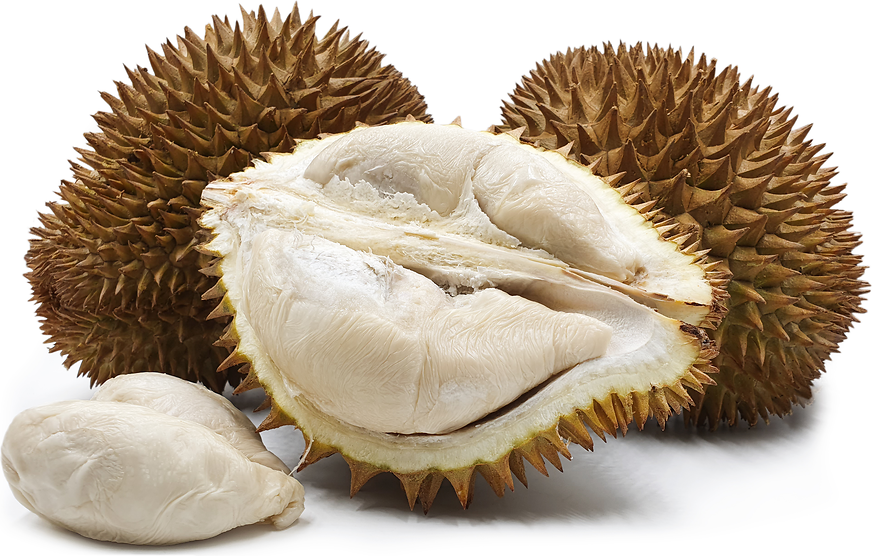


Putih Durian
Estimated Inventory, lb : 0
Description/Taste
Putih durians are small to moderately sized fruits, averaging 15 to 30 centimeters in length, and have an oval to oblong shape, covered in broad, stiff, and conical spikes. The tough, sharp exterior ranges in color from green, yellow, to brown, depending on the specific variety, and underneath the pointed surface, the thick rind has a fibrous consistency that can be sliced or torn open to reveal multi-lobed flesh, surrounded by a white to cream-colored, spongy pith. The flesh widely ranges in color, depending on the growing conditions, and can be found in white, ivory, pale yellow, to orange hues. The flesh is also soft, thick to thin, and slightly sticky with a creamy consistency, encasing flat, small to large seeds. Putih durians vary in taste depending on the specific variety and region grown, but generally have complex flavorings of sweet, savory, pungent, tannic, and nutty notes.
Seasons/Availability
Putih durians are available in the summer.
Current Facts
Putih durians, botanically classified as Durio zibethinus, are pungent, tropical fruits belonging to the Malvaceae family. The name Putih durian is a general term used in Malaysia and Indonesia to encompass many different durian varieties that belong to the zibethinus species. Throughout Southeast Asia, Putih durians are foraged from the wild, cultivated through small farms, and grown in home gardens, creating a wide variation among the fruits. The term kampung-style durian is also used to describe some Putih durians, which are fruits grown from ancient trees with unknown origins. Each durian tree, depending on the region and climate it is grown in, will develop fruits with varying flavors, textures, and appearances. With this widespread, wild diversity, it is challenging for individual varieties of durian to be named for local markets, and durian growers result in using general descriptors to simplify the buying process for consumers. Putih durians are also sold in bunches tied together known as ikats, which are premade groupings of many different durian types.
Nutritional Value
Putih durians are an excellent source of vitamin C, an antioxidant that can help strengthen the immune system and reduce inflammation. The fruits are also a good source of potassium, manganese, copper, and fiber to stimulate the digestive tract and contain some magnesium, zinc, folate, and calcium.
Applications
Putih durians are best suited for both raw and cooked applications, including simmering and baking. The sharp, pointed skin is generally cut open with a knife, and the thick surface is peeled apart, revealing the soft, pungent flesh. Putih durians are primarily eaten fresh, out-of-hand, or the flesh is blended into juices, smoothies, and ice cream. The fruits are also cooked with sugar and made into a paste for cakes, cookies, and pastries, or it is mixed into a filling for tarts, cream puffs, and pancakes. In Malaysia, Putih durians are blended with sago and cream to make a thick and creamy pudding. The flesh can also be incorporated into savory applications, including soups, curries, rice dishes, and relishes. In addition to the flesh, the seeds can be roasted or boiled and eaten as a snack. Putih durians pair well with honey, sugar, caramel, vanilla, coconut water, chocolate, mango, onions, garlic, peas, and soft cheeses such as mozzarella. Whole, unopened Putih durians will keep for a couple of weeks when stored in a cool location. Once sliced, the flesh is best consumed immediately for optimal flavor and can be stored for an additional 2 to 3 days in the refrigerator. The flesh can also be dried or frozen for extended use.
Ethnic/Cultural Info
Throughout Southeast Asia, durian festivals are held for the public during the peak season to celebrate the spikey, custard-like fruits. Each festival itinerary varies, depending on the region, but almost all of the events feature durians with white, yellow, orange, red, and multi-colored flesh. Putih durians are sold at these festivals as affordable varieties. If there is a specific variety of Putih durian known in that region for exceptional flavor, the fruits may be marketed separately from the other fruits as a specialty item. One of the unique experiences that these festivals offer, especially in cities such as Bogor and Kuala Lumpur, is all-you-can-eat durian parties. These samplings allow participants to try many different durian types to experience the complete flavor profiles of wild and cultivated fruits. In the Durio zibethinus species alone, there are hundreds of varieties that are regionally found around Southeast Asia, so each regional festival provides new fruits to experience. Many durian enthusiasts plan their vacations around the durian season in order to visit these events to sample unusual durian varieties.
Geography/History
Durians are believed to be native to regions throughout Southeast Asia, specifically Malaysia and Indonesia, and have been growing wild since ancient times. The term Putih durian encompasses many different wild and cultivated durian varieties with both ancient and modern histories. Today Putih durians are found growing in areas of Peninsular Malaysia, on the island of Borneo in Sabah, Sarawak, and Brunei and on Sumatra and Java. When in season, the fruits are primarily sold through local markets.
Recipe Ideas
Recipes that include Putih Durian. One
| Just a Pinch Recipes |
|
Durian Milk Candy |
| Kitchen Tested |
|
Durian Brown Sugar Buns |
| The Spruce Eats |
|
Durian Ice Cream |
| Hot Thai Kitchen |
|
Durian Sticky Rice |




